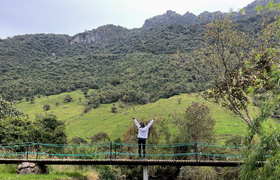
Unforgettable rail journeys: the best train trips in China
From soaring bullet trains to the world’s highest railway, take an epic adventure through China’s ancient cities and wild frontiers by train
Offering a captivating blend of snow-topped mountains, vibrant megacities, ancient marvels, and hidden provinces, China is an enviable destination for the avid traveller. It’s also one of the largest countries on the planet, boasting a total area of about 9.5 million sq km (3.7 million sq mi). This can make it a time-consuming destination to traverse, with huge distances separating some of its most popular sites. But before you start scanning the web for domestic flights, remember that China offers some of the best journeys by rail in the world.
China’s railways are nothing if not majestic. With an impressive infrastructure totalling some 160,000km (nearly 100,000 mi) of train tracks, China continues to invest in high-speed rail. Even the long-rumoured Trans-Himalayan Railway, slated to connect Tibet and Nepal through the Himalayas, could come to fruition. Stow your bags overhead, grab a window seat, and hurtle through the country’s great expanses at speeds of up to 430km/h (267 mph). From bullet trains to cross-country sleepers, here’s our list of the best train journeys in China.
Beijing to Xi’an
A popular option that connects Beijing’s stretches of the Great Wall to the mysterious Terracotta Army near Xi’an, this route is a must for anyone looking to explore the enigmas of China’s ancient past. If you’re tight on time, take a day to visit Badaling or Mutianyu and then catch an early bullet train out of the capital the next morning. It will traverse the 1,134km (705 mi) distance to Xi’an in just over four hours, making both ancient wonders accessible within a shorter trip.
The route is scenic, beginning in Beijing’s urban sprawl and blasting through diverse landscapes to reach the heart of Shaanxi province. If time is not an issue, opt for an overnight train, which takes anywhere from 12 to 17.5 hours. Depending on the ticket class, you can enjoy luxuries like a private compartment and bedding, making the voyage by night smoother and more comfortable. Be sure to do your research and check reviews so you know exactly what you’re paying for.

Experience it for yourself on: Ancient China
Beijing to Lhasa
If travelling to Lhasa from Beijing, prepare to experience the Qinghai-Tibet railway. Starting in the city of Xining in Qinghai province, this route is famed for being one of the highest train lines in the world — so much so that it’s commonly known as the Sky Train. As it cruises the Tibetan Plateau, it reaches an altitude of 5,700m (about 18,700 ft) above sea level, which is higher than the Base Camp at Everest.
The views en route are far from shabby. Prepare for stunning vistas as your train carves past former Silk Road passages and the formidable Kunlun Mountains. You have plenty of time for window-gazing, with the full journey clocking in at about 40 hours, or half that if you’re joining from Xining. Expect to feel some altitude sickness, especially if you’ve never experienced high terrain before, though oxygen is pumped into the cabins during the more extreme sections of the route.
Suzhou to Xi’an
Another route into the city of Xi’an — gateway to the Terracotta Army, Big Goose Pagoda, and the lantern-laden enchantment of the Yanta district — is via Suzhou. Starting in serene gardens and ephemeral water towns, it’s a journey that blends tradition and modernity, showcasing China’s layered identity from ancient dynasties to the present day. It's affectionately nicknamed the "Venice of the East" because of its canal network.
Start your day with a boat ride through Suzhou’s charming waterways before settling into your long journey. High-speed routes between the two can take anywhere from six to 14.5 hours, depending on the time of day, while the sleepers can stretch up to a whopping 20 hours. Don’t forget your pillow and plenty of podcasts to keep you entertained on the way.

Experience it for yourself on: China Express
Kashgar to Urumqi
Take a train from Kashgar, an ancient Silk Road hub, to Xinjiang’s capital, Urumqi, and enjoy a rich display of cultures and landscapes. The trip can take up to 31 hours and is a minimum of 11.5 hours, so there are good opportunities to get some shuteye if you’re tired out from a few days of sightseeing. Set your alarm and wake up in time for some of the more spectacular passages, though — things get particularly special in the Taklamakan Desert, with arid landscapes juxtaposed against the Tian Shan mountain range.
Book your tickets for late Sunday or early Monday so that you can visit Kashgar’s Sunday market before you depart the city. A major bazaar on the Silk Road, this historic trading place is one of the largest markets in Asia and offers a fascinating glimpse into China’s enduring past. Think handicrafts, clothing, and local specialties — be aware that livestock is also traded, so stay clear if this is likely to upset you.
Shanghai to Beijing
Connecting two of China’s most frequently visited cities, the Shanghai to Beijing high-speed train is a convenient way to integrate a taste of the country’s cutting-edge rail services into a classic itinerary. Covering a distance of some 1,300km (820 mi) in four to six hours, this impressive train line is a marvel of engineering and an experience in itself.
It’s also a great way to jumpstart your sightseeing in either city, with train stations centrally located in both. You can get to the Forbidden City by metro within half an hour from Beijing Nan, while you can reach the elegant buildings and waterfront views of Shanghai’s The Bund in about 45 minutes from Hongqiao. This route is a nice option if you’re visiting on a 72-hour visa-free transit because both cities are permitted in the policy, and you will see more of China from the ground than by flying.

Experience it for yourself on: Beijing to Tokyo: The Great Wall & Mt Fuji
Beijing to Ulaanbaatar
What better way to witness China’s contrasting landscapes than with a train ride from Beijing to Ulaanbaatar? Take the opportunity to slow down and experience all that this scenic route has to offer as you shoot through the Gobi Desert and deep into Mongolia’s remote wilderness. At the border, the train undergoes a bogie exchange to accommodate the wider railway track gauges used in Mongolia — not something you see every day!
It’s a long ride, about 35 hours, so think carefully about the class of ticket you want to opt for. Compartments vary between two and four beds, and typically offer a good deal of storage space. From Mongolia, the route morphs into the famous Trans-Siberian railway, crossing five time zones across five days to arrive in Moscow.
Xi’an to Chengdu
An incredibly convenient link, the train journey between Xi'an and Chengdu is a great option if you want to combine a trip to the Terracotta Army with a visit to China’s abominably cute giant pandas. At its shortest duration, the journey takes just a couple of movies, which is impressive considering the distance involved. Slower and cheaper options are also available, including overnight sleeper trains.
The route takes you from Shaanxi province to Sichuan via the agricultural sights of the Guanzhong Plain through the misty peaks and deep valleys of the Qinling Mountains. As you approach Chengdu, prepare for softer vistas with lush greenery, rice paddies, and bamboo forests. After disembarking, start your visit to panda country with a regional favourite, Sichuan’s famous spicy hotpot.

Experience it for yourself on: China: Big Cities & Iconic Culture
Guiyang to Guangzhou
A shorter journey relative to the others on our list and worth budgeting time for is the three- to four-hour ride from Guiyang to Guangzhou. Starting in the lush, mountainous province of Guizhou, you journey some 900km (560 mi) through forested valleys, rural villages, and karst landscapes to reach Guangzhou, the vibrant capital of the southern province of Guangdong. Prepare for scenic views, including the odd winding river and even some misty peaks.
When you arrive in Guangzhou, dive face-first into its famous Cantonese dim sum scene. Think hot steamed bites, fall-to-pieces char siew (roast pork), and fried sweet rice cake. If you’re a culture or history buff, head to Chen Clan Ancestral Hall for brick carvings and mythical decorations before finishing the day with panoramic views at the Canton Tower.
Beijing to Hong Kong
Covering a distance of 2,400km (1,500 mi) and connecting Hong Kong West Kowloon and Beijing West train station, this adventure takes about eight to nine hours and passes through an average of six stops, including Shenzhen, often called China’s Silicon Valley; Guangzhou, a hub for Lingnan cultures; and Zhengzhou, one of China's eight ancient capitals. Hong Kong and China have separate visa and immigration policies, so check regulations and restrictions before making your trip. If you’re travelling between the two by train, you need to complete immigration procedures at the border in Shenzhen.

Experience it for yourself on: China: Natural Sites & City Lights
Nanning to Guilin
The peaceful and oh-so-picturesque train journey from Nanning to Guilin is a short ride (2.5 hours) that packs tons of natural beauty. This route is a great option for travellers interested in getting a first-hand view of some of southern China’s most incredible landscapes. Prepare for rolling hills, lush countryside, and visions to last a lifetime as you close in on Guilin, located in the northeast of Guangxi Zhuang.
Thanks to the jagged limestone karst that surrounds it, the city has an otherworldly feel that’s as timeless as it is awe-inspiring. Once you arrive, get closer to the stunning environment with a long walk or bike ride — you’ll feel like you’re drifting through a living painting. Or better yet, book a river cruise to Yangshuo, one of China’s most scenic river journeys.




